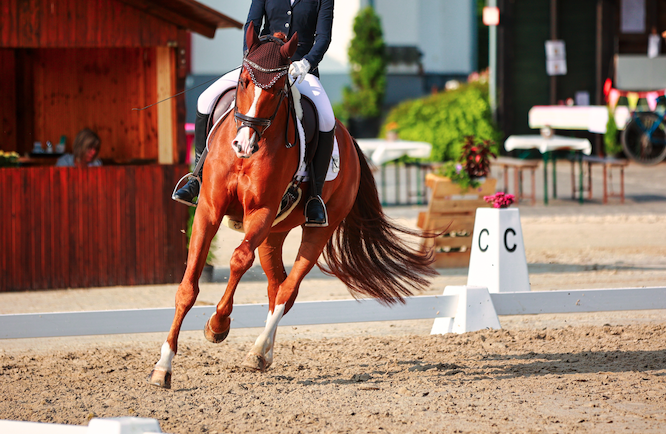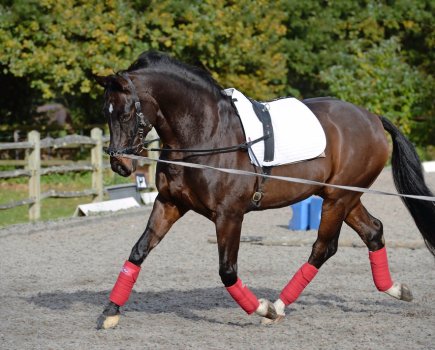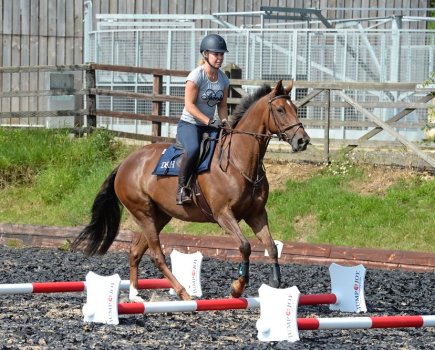Riding a 20m circle is an important skill to master, particularly for any rider who wants to improve their dressage marks. The perfect circle isn’t easy to ride, though, as getting the horse to be correct in the shape, and with uniform bend throughout, is hard.
“Riding a good circle is mainly about the relationship between suppleness and straightness. You need alignment through the whole horse from nose to tail, so a uniform bend from front to back,” explains leading British dressage rider Becky Moody, who was a member of the bronze medal-winning team at the Paris Olympic Games.
Benefits of riding 20m circles
Circles are a great training tool with many benefits to the horse.
“Riding a good circle not only helps to improve a horse’s suppleness, but also makes the rider aware of both sides of their horse,” says Becky.
“When riding different sized circles and adding in transitions, engagement and balance are improved, too.”
Riding smaller circles can also provide a focus if the horse is struggling to maintain concentration when schooling. In fact, it’s important to ride circles of different sizes and to ride them on both reins.
This will ensure that the horse can perform them consistently and confidently in both directions, not least when they’re in front of a judge.
The mechanics of a 20m circle
The main thing to remember is that your circle should be round, not oval. You should be at the same distance from the centre at every step on your circle.
Think of a circle as having four points and ride from point to point on a curved line. Remember, you don’t ride on the outside track at all when you’re riding a 20m circle.
Failing to understand this is a common cause of poorly shaped and inaccurate 20m circles.
“First things first — you need to understand exactly where you are trying to ride,” agrees Paris Olympics team bronze medallist Becky Moody.
“Know the dimensions of the competition arena and the distances between the letters, and the corners and letters.
“When I was little I used to draw myself a mini ‘to scale’ dressage arena with all the letters around, and then I would draw my tests so that I knew exactly where I needed to go.
“Now when I’m riding I think about drawing the shapes in the arena surface with my horse’s feet. I’m a very visual person so I find this really helpful.”
How to ride a 20m circle
For this example in a 20x40m sized arena, ride a 20m circle on the right rein, starting at A:
- Ask for inside flexion just before starting your circle.
- Leave the track at A.
- Touch the outside track halfway between K and E (ie 4m after K).
- Continue your curving line around to X.
- Touch the track halfway between B and F (ie 4m before F).
- Complete your circle at A.
- Make sure the corner you ride immediately before starting your circle, and then immediately after, are clear and deliberate.
Correct horse and rider positioning
“Once you understand where you need to go it’s then about how your horse is going,” states Becky.
“If the horse is too lazy, too speedy, not supple enough, or too bendy, then it’s hard for you to go where you want. Improving their basic way of going will help with this, as will very confidently taking charge of where you are trying to ride.”
Becky recommends riding transitions, squares, diamonds and then riding circles again. Give yourself and your horse constructive and positive things to focus on.
Once you’re back on a 20m circle, how you position your upper body is key.
“Your head and shoulders should always be facing where you want the horse’s head and shoulders to be facing, so either ahead or around the circle,” says Becky.
“If I want to really look ahead to a point I will look with my eyes rather than actually turning my head. Over-turning of the head or body can make you more inclined to put yourself and the horse out of balance.”
Watch your speed
“If your horse is rushing on a circle it is likely that they are also rushing on straight lines. Transitions, therefore, are your friend — lots and lots of them,” advises Becky.
“Initially start with trot-walk-trot transitions, and then try normal trot-small trot-normal trot transitions. Ensure that you are always thinking about getting the horse to listen to your aids and relax.
“As the horse does this they will become ever more responsive to the half-halt, which will enable you to regulate their balance and speed and consequently stop them rushing.”
Falling out through the shoulder
According to Becky, one of the most common causes of a horse falling out through their shoulder is too much inside neck bend.
“If this is the case then straightening the neck or even taking a small amount of outside bend while still being fussy about accuracy will help you to improve your control of the outside of the horse,” explains Becky.
“When that is better you should then be able to think about bringing the bend a little back to the inside while still controlling that outside shoulder.
“Practising exercises like riding diamond shapes will help you to be more disciplined about both sides of the horse.”
Help for a horse’s stiff side
Every horse has a stiffer side and a more supple side.
“As riders it is our job to help make them more supple and evenly balanced,” says Becky. “I say to my pupils that our training sessions should be like a gym session and have a combination of cardiovascular, suppling, strengthening and gymnastic exercise, as well as a bit of Pilates and yoga in there, too.
“If a horse is stiff to the left we have to do exercises to help that. For example, spiral your left rein 20m circle down to 10m, really trying to keep working the bend, and then start to push them back out to the 20m circle again by pushing the girth out first so that it’s almost like a leg yield.”
Another exercise that Becky suggests is on the left rein:
- Turn up the three-quarter line
- Leg yield away from your inside leg
- Then go large and ride a 10m circle left in each corner.
“There are so many exercises that can help, but sometimes just coming back to walk or even halt and helping the horse to realise that they can bend with no other distractions can be really beneficial,” says Becky.
“If none of this seems to be helping, it might be worth getting a good physio to check your horse over to make sure that there isn’t anything making them uncomfortable.”
Main image © Shutterstock; NB Becky Moody is not pictured riding









